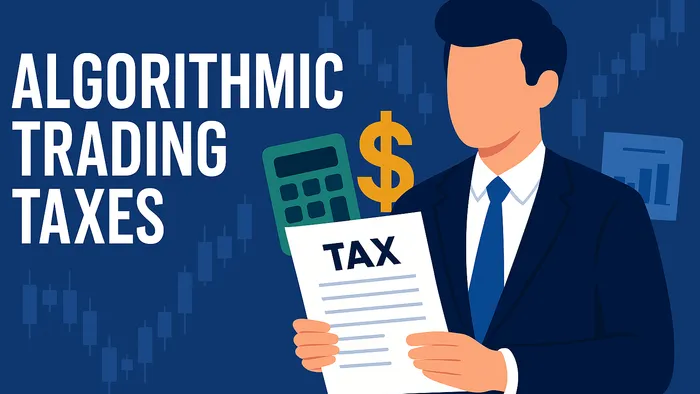Understand the tax implications of algorithmic trading, including trader status, mark-to-market accounting, and effective tax strategies.
Algo trading can boost profits, but it comes with tax challenges. Here is what you need to know to stay compliant and reduce your tax burden:
- Trader vs. Investor Status: Frequent algo traders may qualify for “trader status”, allowing business expense deductions and different tax treatments.
- Short-Term Gains: Profits from quick trades are taxed up to 37 % (2023 rates).
- Mark-to-Market Accounting (MTM): Electing MTM can simplify taxes by avoiding the wash-sale rule and capital-loss limits.
- Record-Keeping: Document every trade (date, price, fees) to ensure accurate reporting.
- Tax-Reduction Strategies: Use tax-advantaged accounts, loss harvesting, and professional advice to minimise liabilities.
Quick Comparison
| Strategy | Benefits | Considerations |
|---|---|---|
| Trader Status | Deduct expenses, ordinary-income treatment | Strict IRS criteria to qualify |
| Business Incorporation | Tax flexibility, liability protection | Higher setup and maintenance costs |
| Mark-to-Market (MTM) | Avoid wash-sale rule, no capital-loss limits | Must elect by prior-year tax deadline |
| Tax-Advantaged Accounts | Tax-deferred or tax-free growth | Limited to specific account types such as IRAs |
Understanding these basics will help you navigate algo-trading taxes effectively and make informed decisions for your financial goals.
Why Active Day Traders Need to Elect Mark-to-Market Accounting
Tax Rules for Algo Traders
Your tax classification plays a big role in determining your liabilities and deductions. The IRS has clear rules for how trading activity is taxed, and understanding these can save you money.
Trader vs. Investor Status
The IRS differentiates between traders and investors based on trading habits, and this distinction impacts both tax treatment and deductions.
| Characteristic | Trader | Investor |
|---|---|---|
| Trading Pattern | Frequent, often daily, with a portfolio turnover of 3× or more annually | Infrequent, no regular pattern |
| Holding Period | Typically 30 days or less | Combination of short- and long-term holds |
| Income Source | Short-term gains from market movements | Dividends, interest, long-term growth |
| Time Commitment | Full-time or near full-time activity | Part-time, often outside work hours |
| Expense Treatment | Deducted as ordinary business expenses | Itemised deductions, subject to AGI limits |
For algo traders, qualifying as a trader can be advantageous. Business expenses are treated as ordinary deductions, bypassing the limitations tied to adjusted gross income (AGI). This classification also determines how your income is taxed, as explained below.
Types of Trading Income
Short-term trading generates income taxed at ordinary rates, which can reach 37 % for high earners. Long-term positions qualify for lower tax rates. To further optimise taxes, mark-to-market (MTM) accounting can be a valuable strategy.

Mark-to-Market Trading
Under IRC § 475(f), traders using MTM accounting report all securities as inventory, treating both realised and unrealised gains and losses as ordinary income. While this can increase tax liability in profitable years, it offers key advantages:
- No wash-sale rule: Eliminates the need to track wash sales.
- No $3,000 capital-loss limit: Losses are treated as ordinary losses without the cap.
- Business-expense deductions: Expenses are fully deductible.
- Ordinary-loss treatment: Losses can offset other income.
The Financial Accounting Standards Board outlines three levels for valuing assets under MTM:
- Level 1: Assets with clear market prices.
- Level 2: Assets valued using comparable market data.
- Level 3: Illiquid assets requiring internal valuation models.
If you are considering MTM status, it is essential to consult a tax professional. Timing is critical, as the election must be made by the original due date of the prior-year tax return. This strategy is not for everyone, so ensure it aligns with your trading style and financial goals.
Tax Problems in Algo Trading
Algorithmic traders face unique tax challenges due to the fast-paced nature of their operations. Properly managing these issues is key to staying compliant and ensuring accurate tax reporting.
Trade Record-Keeping
Keeping detailed records can be daunting in high-frequency trading. Every trade needs meticulous tracking to meet tax requirements.
| Essential Trade Details | Required Documentation | Purpose |
|---|---|---|
| Date and timestamp | Trade confirmations | Calculating cost basis |
| Asset details | Account statements | Determining gains or losses |
| Buy or sell price | Order books | Assessing tax liability |
| Transaction fees | Tax-related documents | Claiming expense deductions |
| Trading pairs | Exchange records | Verifying income |
To simplify this process, platforms such as TraderFyles offer dedicated solutions. Their Essential plan costs $89 per year and supports up to 1,000 trades annually, while the Premium plan, at $899 per year, handles up to 10,000 trades. Clear records are especially important for addressing the wash-sale rule, a common issue for high-frequency traders.
Wash-Sale Management
The wash-sale rule can be a headache for algo traders. It prevents loss deductions if the same or similar securities are repurchased within 30 days of being sold at a loss.
One quantitative hedge fund tackled this by adding a specialised module to its trading system. The module reviews past trades, flags potential wash-sale violations, and suggests alternative securities to maintain portfolio balance. While wash sales are a domestic concern, international trading introduces its own set of tax hurdles.
International Trading Taxes
For U.S.-based algo traders, international trading adds another layer of complexity. All foreign trades must be reported in U.S. dollars on tax returns.
Key points to consider include:
- Converting all transactions to USD at execution time
- Navigating relevant tax-treaty rules
- Keeping separate records for domestic and international trades
- Tracking foreign-transaction fees
For example, in February 2025, Kryptos.io assisted a trader managing thousands of trades daily across multiple exchanges. Their automated solution streamlined Form 8949 and Schedule D reporting, significantly reducing manual work.
Effectively addressing these challenges sets the stage for exploring tax-saving strategies, which are covered next.
Tax Reduction Methods
Reducing tax liability requires smart strategies combined with accurate record-keeping and strict compliance.
Trading in Tax-Advantaged Accounts
Using tax-advantaged accounts can lower the tax impact of algorithmic trading. Self-directed IRAs, for example, are useful for traders focused on futures and alternative investments. These accounts allow you to defer or even eliminate taxes on trading profits.
| Account Type | Trading Benefits | Tax Perks |
|---|---|---|
| Self-Directed IRA | Access to alternative assets | Growth is tax-deferred |
| Roth IRA | Suitable for short-term trades | Withdrawals are tax-free in retirement |
| Traditional IRA | Active trading allowed | May qualify for immediate deductions |
| 401(k) | Employer matching possible | Contributions made pre-tax |
Trades within retirement accounts do not qualify for Trader Tax Status (TTS). To maximise efficiency, consider using a mix of taxable and tax-advantaged accounts depending on your strategy. Actively managing losses can further reduce your tax burden.
Loss-Harvesting Steps
Tax-loss harvesting can improve returns. Studies suggest an annual boost of 0.9 % to 5 %.
“They can be used to offset capital gains incurred during the same tax year when the losses occurred, carried forward to offset capital gains in future years, and offset up to $3,000 of ordinary income each year.”
– David Tenerelli, Certified Financial Planner at Strategic Financial Planning
Apply tax-loss harvesting effectively by following these steps:
- Identify investments with unrealised losses.
- Sell underperforming assets while following wash-sale rules.
- Reinvest in similar, but not identical, securities to maintain market exposure.
Consulting a Tax Expert
A tax professional can confirm trader status and fine-tune your strategy. After setting up the right accounts, expert advice helps you go further. Professionals assist with:
- Evaluating whether incorporation is beneficial
- Selecting the best account types
- Ensuring compliance with tax laws
- Automating trade-tracking systems
Seek advisors experienced in both algorithmic trading and cryptocurrency taxation. An expert can help integrate trade data into IRS forms such as Form 8949, ensuring accurate reporting and maximising deductions.
Next Steps and Resources
Main Points Summary
To tackle tax challenges effectively, focus on key compliance requirements. Here is a quick breakdown:
| Requirement | Action Steps | Why It Matters |
|---|---|---|
| Trade Documentation | Track trades in real-time with timestamps and values | Creates a clear, verifiable record |
| Method Selection | Choose between FIFO or Specific-Identification methods | Ensures a consistent tax basis |
| Status Determination | Assess if you qualify as a trader | May provide tax-saving benefits |
| Professional Support | Consult crypto-savvy tax experts | Helps maintain compliance |
These steps provide a solid foundation for managing tax obligations more effectively.
Helpful Tools and Services
Managing taxes is smoother with the right software and market-analysis resources.
Tax-Reporting Platforms
TraderFyles offers tiered plans to fit different trading volumes:
- Essential Plan: $89 per year for up to 1,000 trades
- Active Plan: $279 per year for up to 3,000 trades
- Premium Plan: $899 per year for up to 10,000 trades
Market-Analysis Tools
LuxAlgo provides indicator toolkits on TradingView and an AI Backtesting platform:
- Free Plan: $0, lifetime access to hundreds of indicators in the LuxAlgo Library
- Premium Plan: $39.99 per month, advanced signals, alerts, and oscillator toolkits
- Ultimate Plan: $59.99 per month, access to AI Backtesting and all premium features
These tools connect with major trading platforms and can export data directly to tax forms such as Form 8949. Pair automated software with expert advice, and schedule quarterly reviews to align trading strategies with tax-planning goals.








